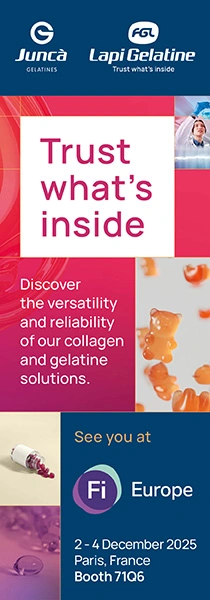KHS Revolutionizes Aseptic Cold Filling
In order to maintain class 100 clean room conditions, appropriately prepared sterile air is supplied directly to the neck ring isolator through a HEPA filter.
11/08/06 With its new neck ring isolator, KHS once again revolutionizes aseptic cold filling. The neck ring isolator concept is based on KHS' state-of-the-art method of dry sterilization according to the mini-isolator technology and represents a world innovation in the truest sense of the word.
The key advantage of this new neck ring isolator concept: The required class 100 clean room occupies almost less than 1 percent of the space needed for the KHS ACF wet sterilization concept. The volume of class 100 clean room needed in order to use the neck ring isolator is a mere 10 percent of the clean room space required for the KHS ACF dry sterilization concept based on the mini-isolator technology.
The neck ring isolator maintains a class 100 clean room atmosphere in the mouth area upward beginning with the neck ring, which thus includes container interiors. Sterilization of bottle exteriors is not necessary. Moreover, the bottle shape and the type of bottle materials below the neck ring may vary as desired and do not affect the handling system in the machine.

As a result, those who process plastic bottles today are able to process carton bottles tomorrow thanks to the innovative neck ring isolator concept - whereby the emphasis here is on "bottles" - for one thing is decisive for guiding the containers: the neck ring. The system is able to process two different mouth sizes - very much in line with requirements and for the most part automatically switchable.
In order to maintain class 100 clean room conditions, appropriately prepared sterile air is supplied directly to the neck ring isolator through a HEPA (high-efficiency particulate air) filter. A laminator, shaped like a perforated sheet, rotating together with the treatment stations and filling valves maintains a laminar flow of air in the neck ring isolator immediately above the open bottle mouths thereby eliminating the potential risk of germs remaining in the neck ring isolator. A slight amount of overpressure constantly prevails in the isolator.
Similar to the KHS ACF method of dry sterilization according to the mini-isolator technology, the neck ring isolator concept sterilizes interior bottle surfaces and bottle mouths with hydrogen peroxide (H2O2) that is dried in the sterilizer/activator zone free of residue. The Innofill NV uses open-jet filling valves for non-contact, volumetric filling. No-drip filling of the Innofill NB is ensured by a special gas lock at the product outlet. The capping process is controlled by an ACF-compliant Innofill SV-ACF capper.
All considered, the neck ring isolator concept is not only a world innovation in the field of aseptic cold filling but at the same time a new development with plenty of future potential. Above all because, in addition to the extremely low clean room space requirements, this concept ensures the so very necessary maximum filling safety under aseptic conditions while simultaneously providing loads of cost benefits versus the aseptic filling concepts available to date.












